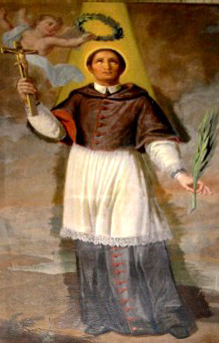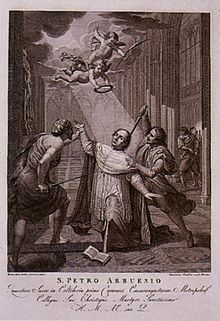Pedro de Arbués: Difference between revisions
m Disambiguate Castile to Crown of Castile using popups |
Optymystic (talk | contribs) m →Life: Removing verbiage - there wastoo much redundancy in the text |
||
| Line 33: | Line 33: | ||
He underwent his [[Philosophy|philosophical studies]] perhaps in [[Huesca]] but later travelled to [[Bologna]] on a scholarship to the [[Collegio di Spagna|Spanish College of Saint Clement]] which was part of the [[University of Bologna|Bologna college]]. He obtained his doctorate in 1473 while he served as a professor of moral philosophical studies or ethics.<ref name=NA/> Upon his return to Spain he became a member of the [[cathedral chapter]] of the [[canons regular]] at La Seo where he made his [[profession (religious)|religious profession]] in 1474.<ref name=SQPN/><ref name=SEB/> |
He underwent his [[Philosophy|philosophical studies]] perhaps in [[Huesca]] but later travelled to [[Bologna]] on a scholarship to the [[Collegio di Spagna|Spanish College of Saint Clement]] which was part of the [[University of Bologna|Bologna college]]. He obtained his doctorate in 1473 while he served as a professor of moral philosophical studies or ethics.<ref name=NA/> Upon his return to Spain he became a member of the [[cathedral chapter]] of the [[canons regular]] at La Seo where he made his [[profession (religious)|religious profession]] in 1474.<ref name=SQPN/><ref name=SEB/> |
||
At around that time [[Ferdinand and Isabella]] had obtained from [[Pope Sixtus IV]] a [[papal bull]] to establish in their kingdom a tribunal for searching out [[heretics]]. Those [[Jews]] who had received [[baptism]] were known as [[Converso|conversos]]; some might have continued to practice [[Judaism]] in secret.<ref name=NA/><ref name=SEB/> [[Tomás de Torquemada]] - in 1483 - was appointed as the Grand Inquisitor for [[Crown of Castile|Castile]] and appointed Arbués and Pedro Gaspar Juglar as Inquisitors Provincial in the [[Kingdom of Aragon]] on 4 May 1484. Their work was received in the kingdom with opposition - not just from converts - from sectors of the population who saw it as a threat to their freedoms.<ref name=NA/><ref name=SQPN/> |
|||
On 14 September 1485 he was attacked in the cathedral and |
On 14 September 1485 he was attacked in the cathedral and despite wearing a helmet and chain mail he died from his wounds on 17 September. He was attacked during the evening as he knelt before the altar and had been wearing armour since he knew his work posed great risks.<ref name=NA/> The Inquisition's reception was poorly received in [[Aragon]] where it was seen as an imperial-led attack on the charters, privileges and local laws. It seems that some of the most powerful families among the converted Jews - such as the Sánchez and the Montesa as well as the Paterno and Santangel families - were involved in the murder. His remains were entombed in a special chapel dedicated to him.<ref name=SQPN/><ref name=SEB/> |
||
As a result, a popular movement against the Jews arose in which "nine were finally executed in person, and two suicides, thirteen burnings in effigy, and four punished for complicity" according to the historian [[Jerónimo Zurita]]. This all took place from 30 June to 15 December 1486. [[Leonardo Sciascia]] in ''Morte dell'inquisitore'' (1964) writes that Arbués along with Juan Lopez Cisneros (d. 1657) are "the only two cases of inquisitors who died assassinated".<ref name=SEB/><ref>{{citeweb|url=http://www.jewishencyclopedia.com/articles/1725-arbues-pedro|title=ARBUES, Pedro|author=Richard Gottheil, Meyer Kayserling and William Milwitzky|date=|accessdate=20 September 2017|publisher=Jewish Encyclopedia}}</ref> |
|||
==Sainthood== |
==Sainthood== |
||
Revision as of 10:50, 17 October 2017
 Depiction. | |
| Priest; Martyr | |
| Born | ca. 1441 Épila, Kingdom of Aragon |
| Died | 17 September 1485 (aged 44)[1] Zaragoza, Kingdom of Aragon |
| Venerated in | Roman Catholic Church |
| Beatified | 20 April 1664, Saint Peter's Basilica, Papal States by Pope Alexander VII |
| Canonized | 29 June 1867, Saint Peter's Basilica, Papal States by Pope Pius IX |
| Major shrine | Cathedral of the Savior, Zaragoza, Spain |
| Feast | 17 September |
| Attributes |
|
| Patronage |
|
Saint Pedro de Arbués (c. 1441 – 17 September 1485) was a Spanish Roman Catholic priest and a professed canons regular.[2] He served as an official of the Spanish Inquisition who was assassinated in the La Seo Cathedral in Zaragoza in 1485 in an alleged plot that conversos and Jews planned and carried out.[3] The veneration towards him became quick and he became venerated as a saint through popular acclaim. His death had further assisted to a great degree in the Inquisition and for its Inquisitor General Tomás de Torquemada in their campaign against heretics and crypto-Jews.
His canonization, though deemed controversial by some, was celebrated on 29 June 1867.[4]
Life
Pedro de Arbués was born at Épila in the region of Zaragoza to the nobleman Antonio de Arbués and Sancia Ruiz.[4]
He underwent his philosophical studies perhaps in Huesca but later travelled to Bologna on a scholarship to the Spanish College of Saint Clement which was part of the Bologna college. He obtained his doctorate in 1473 while he served as a professor of moral philosophical studies or ethics.[3] Upon his return to Spain he became a member of the cathedral chapter of the canons regular at La Seo where he made his religious profession in 1474.[2][4]
At around that time Ferdinand and Isabella had obtained from Pope Sixtus IV a papal bull to establish in their kingdom a tribunal for searching out heretics. Those Jews who had received baptism were known as conversos; some might have continued to practice Judaism in secret.[3][4] Tomás de Torquemada - in 1483 - was appointed as the Grand Inquisitor for Castile and appointed Arbués and Pedro Gaspar Juglar as Inquisitors Provincial in the Kingdom of Aragon on 4 May 1484. Their work was received in the kingdom with opposition - not just from converts - from sectors of the population who saw it as a threat to their freedoms.[3][2]
On 14 September 1485 he was attacked in the cathedral and despite wearing a helmet and chain mail he died from his wounds on 17 September. He was attacked during the evening as he knelt before the altar and had been wearing armour since he knew his work posed great risks.[3] The Inquisition's reception was poorly received in Aragon where it was seen as an imperial-led attack on the charters, privileges and local laws. It seems that some of the most powerful families among the converted Jews - such as the Sánchez and the Montesa as well as the Paterno and Santangel families - were involved in the murder. His remains were entombed in a special chapel dedicated to him.[2][4]
As a result, a popular movement against the Jews arose in which "nine were finally executed in person, and two suicides, thirteen burnings in effigy, and four punished for complicity" according to the historian Jerónimo Zurita. This all took place from 30 June to 15 December 1486. Leonardo Sciascia in Morte dell'inquisitore (1964) writes that Arbués along with Juan Lopez Cisneros (d. 1657) are "the only two cases of inquisitors who died assassinated".[4][5]
Sainthood

Pope Alexander VII beatified the late priest in Rome on 20 April 1664.
His canonization was celebrated on 29 June 1867 but the canonization itself aroused protests from not just Jews but from Christians as well. Pope Pius IX said in the document formalizing the canonization (Maiorem caritatem): "The divine wisdom has arranged that in these sad days, when Jews help the enemies of the church with their books and money, this decree of sanctity has been brought to fulfillment".[6]
See also
Notes and references
- ^ "Arbués, Pedro de". Gran Enciclopedia Aragonesa. Retrieved 20 September 2017.
- ^ a b c d "Saint Peter Arbues". Saints SQPN. 19 September 2017. Retrieved 20 September 2017.
- ^ a b c d e Anthony Allaria (1911). "St. Peter of Arbues". The Catholic Encyclopedia: Vol. 11 New York: Robert Appleton Company. Retrieved 2 May 2015.
- ^ a b c d e f "Saint Peter Arbues". Santi e Beati. Retrieved 20 September 2017.
- ^ Richard Gottheil, Meyer Kayserling and William Milwitzky. "ARBUES, Pedro". Jewish Encyclopedia. Retrieved 20 September 2017.
- ^ Garry Wills (23 September 2001). "The Popes Against the Jews: Before the Holocaust"". New York Times. Retrieved 20 September 2017.
{{cite web}}: Italic or bold markup not allowed in:|publisher=(help)
Further reading
- Simon Whitechapel, Flesh Inferno: Atrocities of Torquemada and the Spanish Inquisition (Creation Books, 2003). ISBN 1-84068-105-5
 This article incorporates text from a publication now in the public domain: A. Allaria (1913). "St. Peter of Arbues". In Herbermann, Charles (ed.). Catholic Encyclopedia. New York: Robert Appleton Company.
This article incorporates text from a publication now in the public domain: A. Allaria (1913). "St. Peter of Arbues". In Herbermann, Charles (ed.). Catholic Encyclopedia. New York: Robert Appleton Company.- Pedro Arbues in the public domain Jewish Encyclopedia, Funk and Wagnalls, 1901 - 1906.
External links
- 1440s births
- 1485 deaths
- 15th-century Christian saints
- 15th-century Spanish people
- 15th-century Roman Catholic martyrs
- 15th-century Roman Catholic priests
- 15th-century venerated Christians
- Aragonese people
- Canonizations by Pope Pius IX
- Burials at La Seo Cathedral
- Canonical Augustinian saints
- Inquisitors
- Martyred Roman Catholic priests
- People from Zaragoza
- Spanish Roman Catholic priests
- Spanish Roman Catholic saints
- University of Bologna alumni
- Venerated Catholics
